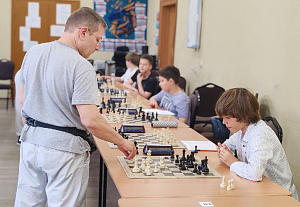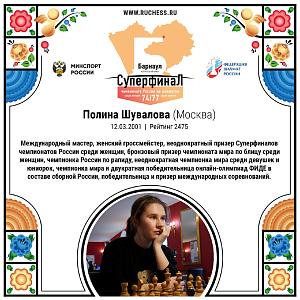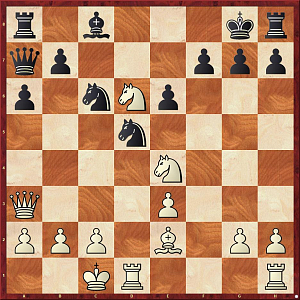Up the Open Line
Maxim Notkin reviews Rounds 13-14 of the FIDE Women's Candidates Tournament
The final stretch, despite its lack of sporting importance, did not turn into a mere formality. Most games were very tense, and two of them became gems of the tournament. Let us examine other curious moments of the final rounds first, and then turn to brilliancies.
Gunina ended the competition with two defeats. The first game did not go well already in the opening, the second one gone wrong somewhere around the time control.
V. Gunina – А. Muzychuk
1.e4e5 2.Nf3 Nc6 3.Bc4 Nf6 4.Ng5 d5 5.exd5 Na5 6.Bb5+ c6 7.dxc6 bxc6 8.Bd3 Nd5 9.h4.
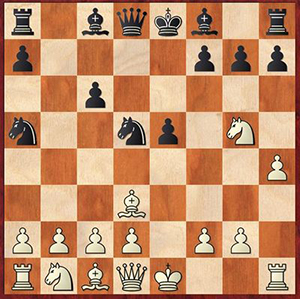
The game, having started in the principled variation of the Two Knights Defense, now turns to a sideline. Black tested9...Nf4 10.Bf1and9...Be7 10.Qf3 with mutual chances more often. Muzychuk's simple yet rare move is completely playable as well.
9...h6 10.Qh5 Qf6 11.Nh7. 11.Nxf7? cannot be recommended– 11...Nf4! (avoiding a naive trap) 12.Qxe5+ Kxf7 13.Qxa5 Bd6 – White wins three pawns, but is terribly underdeveloped. 11.Ne4 is a viable alternative.
11...Rxh7 12.Bxh7 g6.
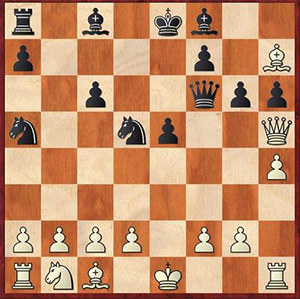
I. Popov-Moskalenko, Moscow 2018, continued13.Qe2 Nf4 14.Qf3with a complicated game.Valentina probably mixed something up, as she played 13.Qf3 at once, and after 13...Qxf3 14.gxf3 Nf6,instead of15.Bxg6 fxg6, gave away the bishop for free: 15.d3 Nxh7.
A bishop and a knight are clearly superior to a rook in this complex ending. Anna did not rush converting her advantage. The only other significant event of this game was the move that required seven zeros in the notation: 20.0-0-0 0-0-0.
Tan Zhongyi– V. Gunina
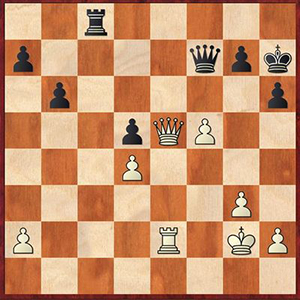
Initially the ending was balanced, but Black was too slow with her queenside counterplay and eventually mixed things up on the kingside.
38…Qh5. This is not a mistake yet, but the tendency is alarming.
39.Qe6 Rc6 40.Qe5 Qg4?! Repeating the moves to pass the time control looks like a good idea – 40...Rс8. 40...b5 is also playable.
41.h3 Qh5?! 41...Qg5 is mandatory, and after42.Qxd5 Rc3 43.Qe5 Rd3 Black's drawing chances, despite the missing pawn, are higher than White's winning chances.
42.g4 Qh4 43.Qe8. Naturally, Tan does not fall for43.Qxd5?? Rc3. Now Black's situation is alarming indeed, however, after43...Qf6 44.h4 Rc7 she can probably defend successfully.
43...Rf6?
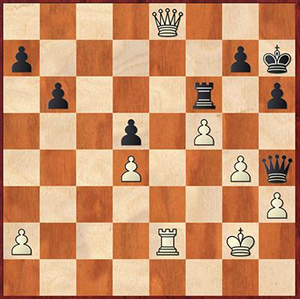
44.Qc8! The most accurate reply that creates a threat to invade the 8th rank and protects the f5-pawn.
44...Qg5 45.Kg3. Black has no checks and cannot play Rxf5. She can only hope for a trap.
45...Rf7 46.h4. Theimpatient 46.Re8? allows Black to survive by 46...Rf8!
46...Rf8. 46...Qf6 loses a queen: 47.Re8 g6 48.fxg6+Kxg6 49.Re6.
47.hxg5. After 47.Qxf8 Qc1 all White needs is basic accuracy, but Tan figures that the resulting rook ending does not require even that.
47...Rxc8 48.g6+ Kg8 49.Re7, and White won easily.
The day before, the Chinese missed a clear scoring opportunity.
K. Lagno – Tan Zhongyi
After several mediocre opening moves by Kateryna, Black got an unexpected development lead. Her initiative then transformed into an extra pawn, however, later Tan allowed her opponent to develop some activity.
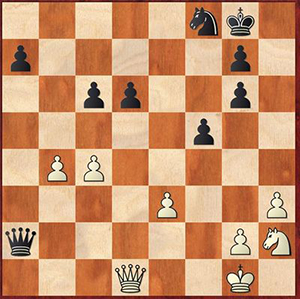
33...Qxc4. The computer suggests 33...Qa3! with the plain idea to win a pawn after 34.Qxd6 Qxe3+ 35.Kf1 Qc1+ 36.Kf2 Qxc4 and the less obvious idea of 34.Qd2 Qa1+ 35.Kf2 Nd7! 36.Qxd6 Nf6! – Black returns material and creates threats to the king. The text maintains Black's advantage as well.
34.Qxd6 Qd5 35.Qb8 Qb3? 35...c5! was required. After36.bxc5 (36.Qxa7 cxb4 is clearly bad for White,andafter 36.Qb5 Qd1+ 37.Nf1 cxb4 38.Qxb4 Qd3 leads to the situation similar to the main line) 36...Qxc5 37.Qb3+ Kh7 Black has a remote passed pawn, while White needs to forget about her activity, take care of the e3-pawn, and allow the f8-knight to relocate to a more promising spot.
36.Qxa7 Qxb4 37.Qa2+ Kh8 38.Qf7.
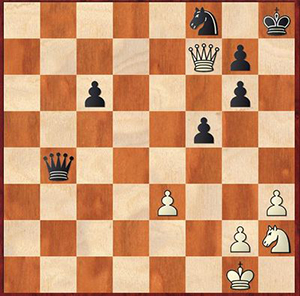
The knight is blocked, the passed pawn does not advance. After38...Qb1+ 39.Nf1 Qb8 40.Nd2 Qd8 41.Nf3 Qf6 42.Qc7 White equalized, and the game was drawn soon.
Mariya Muzychuk co-authored both brilliancies mentioned above.
A. Kosteniuk – M. Muzychuk
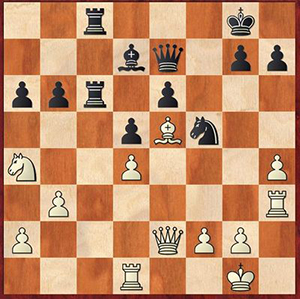
Up to this moment, this was a good positional game. Black's next move, however, creates a tactical mess.
31...Qa3. 31...Nxh4? is no good because of 32.Qh5. However, losing Black's own pawn on the rim was not called for. After 31...a5 her forces are coordinated much better.
32.Qxa6 Qxa2. After 32...Rc1 33.Rxc1 Rxc1+ 34.Kh2Qxa2 White cannot play 35.Qb7? Qxf2, however, she holds the balance by pushing the rook away first – 35.Bf4 or 35.Qa8+ Bc8 36.Bf4.
33.Qb7 Qe2. 33...Rd8 is not worse than the move in the game, but clearly contradicts Black's previous actions.
34.Qxd7! Qxd1+ 35.Kh2.
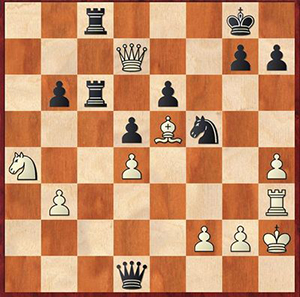
35...Qc1?! The queen needs to return home as soon as possible. After35...Qh5! 36.Nxb6 Qe8 Black avoids the immediate disaster. The most practical solution to37.Qb7!is37...Rxb6 38.Qxb6 Rc2 – Black has sufficient counterplay for a pawn, attacking the f2 andh4 secures her equal chances. 37...Rd8 is more risky. We shall not dig deep into the pro and cons of the immediate 38.Rf3 compared to38.Rg3 g6 39.Rf3 (although in general weakening the 7th rank should be bad for Black), and will only demonstrate the drawing mechanism: 38.Rg3 Rxb6! 39.Rxg7+ Kf8 40.Qa7Ra8 41.Qc7 Rc8 42.Rf7+ Kg8 43.Rg7+Kf8.
36.Rg3?! White can also choose the brutal 36.g4, forcing the endgame with two minor pieces against a rook and a pawn: 36...Rf8 (36...Qd2 loses to 37.Rf3) 37.gxf5 Rf7 38.Qd8+ Rf8 39.Qg5Qxg5 40.hxg5 Rxf5 41.f4, or the subtle36.Rf3Qh6 37.g3! The threat of capturing onb6 once again requires attention of the queen: 37...Qg6 38.Nxb6 Qe8 39.Qb7. If we compare this position to the position after the 37th move in the previous line, we can see that here White is better coordinated and protects both f2- and h4-pawns, thus making Black's counterplay after an exchange sacrifice less dangerous.
36...Qh6. 36...g6 is bad because of 37.Rg5, and the threat of eliminating the protector of the g7-square decides the game.
37.Rg4.
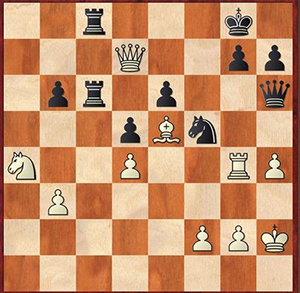
Here Mariya played 37...Rc2?, missing the interposing 38.Nc5!, which quickly ended the game.
38...Ra8 (both 38...R2xc5 39.dxc5 and 38...bxc5 39.Qxc8+ Kf7 40.Qd7+Kf8 41.dxc5 Rxc5 42.Rb4 are hopeless) 39.Nxe6 Rxf2 40.Qxd5 Ra5 41.Qd8+ Kf7 42.Ng5+. Black resigns.
37...g6 38.Nxb6 could lead to a very exciting game. Objectively, Black's best shot is38...Qf8, parting with an exchange and hoping to survive due to temporarily awkward placement of the white rook.
Naturally, 38...Nxh4!? is more tempting – 39.Nxc8?? Nf5+ 40.Kg1 Rc1#. White's only defense is 39.Bf4!, attacking the queen and controlling the c1-square.
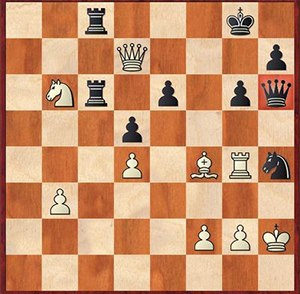
The game continues as follows: 39...Qh5 40.Nxc8 Nf5+ 41.Kg1Qxg4 42.Ne7+! (White is not satisfied with the perpetual after 42.Qxc6 Qd1+ 43.Kh2 Qh5+) 42...Kf8! (after 42...Nxe7 43.Qe8+ Kg7 44.Qxe7+Kg8 45.Be5 White's excellently coordinated queen and bishop either deliver mate or win a rook: 45...Rc1+ 46.Kh2 Qh5+ 47.Kg3Rc3+ 48.f3 Qh6 49.Qxe6+ Kf8 50.Bd6+ or45...Qd1+ 46.Kh2 Qh5+ 47.Kg3 Qh6 48.Qe8+Qf8 49.Qxc6).
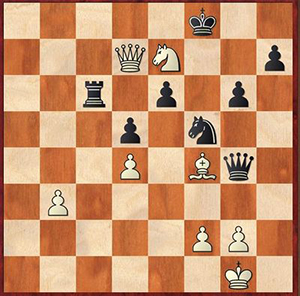
43.Qd8+! Kf7 44.Nxf5.
There is no perpetual: 44...Qd1+ 45.Kh2 Qh5+ 46.Nh4.
44...Qxf5 loses to 45.Qd7+ Kg8 46.Bh6. And after 44...exf5 White solidifies her bishop and then creates the winning attack against the king: 45.Qd7+ Kg8 46.Qxd5+ Kf8 47.g3 or44...gxf5 45.Qd7+ Kg6 46.g3 Ra6 47.Kg2 (47.f3! is even more powerful).
On the concluding day of the tournament, its winner suffered her first defeat.
M. Muzychuk – A. Goryachkina
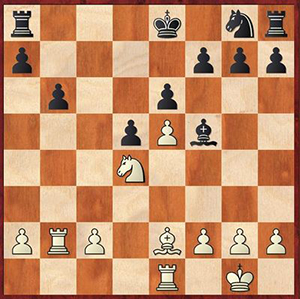
In the sharp and extensively studied variation of the Caro-Kann, the former World Champion employed a rare idea.
15.h4. Usually White looks for an advantage in 15.Bb5+ Kf8 16.Nxf5 exf5 and then 17.Rb3, or17.c4 dxc4 18.Bxc4.
15...Be4? The threat of losing the bishop could be parried by 15...h5, but Aleksandra impulsively decides to save it from being exchanged as well.
16.Bb5+ Kf8 17.f3 Bg6 18.Re3! Black is unable to neutralize the rook's activity on the 3rd rank.
18...Ne7. If 18...Rc8, then 19.Ra3 Rc7 20.Bf1! followed by Nb5.
19.Rc3.
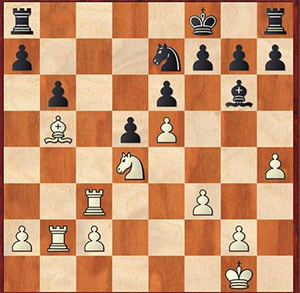
19...h5. Black's position is not enviable after 19...Rc8 20.Rxc8+ Nxc8 21.Rb3 (white rooks are very interchangeable, black rooks are not) 21...f6 (after 21...Ke7 22.Rc3 Kd8 23.Nc6+ Kc7 24.Ba6 White wins material) 22.Rc3 Ne7 23.f4!, followed by the 7th rank invasion.
20.Rc7 a6. 20...Bf5 is more tenacious. The move in the text allows White to gain influence on the queenside.
21.Bd7 b5 22.a4 bxa4. After 22...Nf5 23.Nxf5 Bxf5 24.Bc6Rd8 25.a5! the a-pawn turns very dangerous.
23.Bxa4 Nf5.
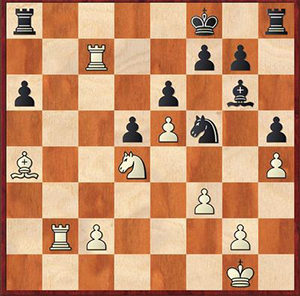
24.Ra7! Mariya obtains a decisive advantage with nice tactical blows.
24...Rd8. After 24...Rxa7 25.Rb8+ Ke7 26.Nc6+Kd7 27.Nxa7+ Kc7 28.Rxh8 Black loses a rook, and after24...Rc8 White wins an exchange by 25.Bd7! Nxd4 26.Bxc8 Kg8, which is probably the lesser of evils for Black.
25.Nc6 Re8. The rook does not find a safe place after 25...Rc8 26.Rc7! Ra8 27.Nb8 Kg8 28.Bc6 either.
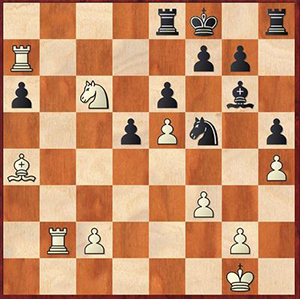
26.Ne7! Rd8 27.Nxg6+ fxg6 28.Bd7. 28.Rbb7 is even more energetic: 28...Kg8 29.g4 hxg4 30.fxg4 Rxh4 31.gxf5 Rg4+ (31...Rxa4 32.Rxg7+ Kf8 33.Raf7+ Ke8 34.fxe6) 32.Kf2 gxf5 33.Bd7.
28...Kg8 29.Bxe6+ Kh7 30.Rbb7 Nd4. Or30...Nxh4 31.Rxg7+ Kh6 32.Rgf7,and there is no adequate defense against the threat of g3.
31.Bd7 Rb8 32.e6, and soon the central passed pawn forced Black to resign.














